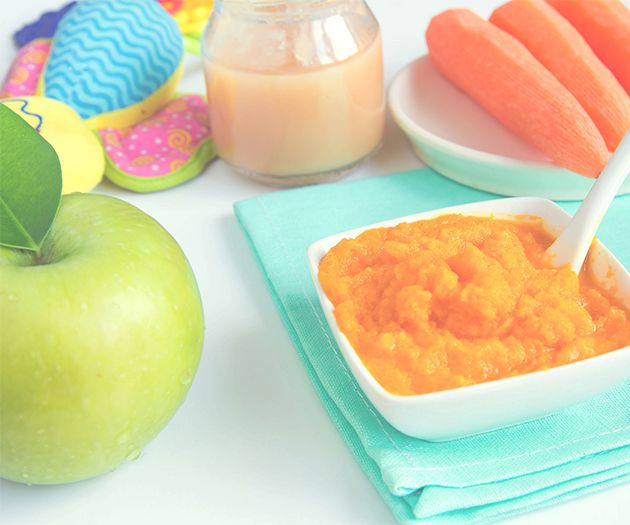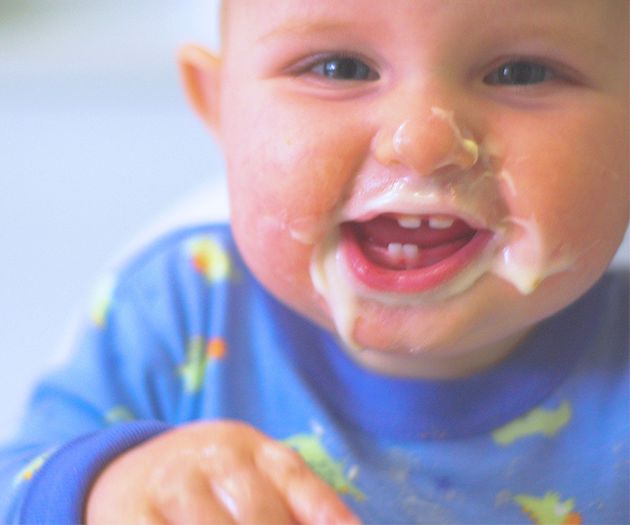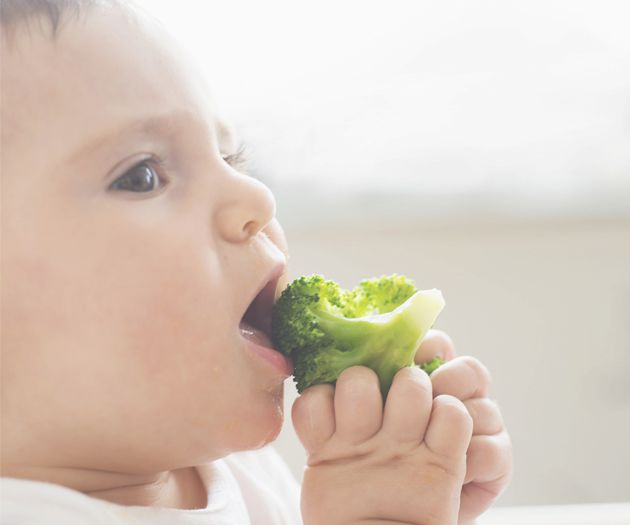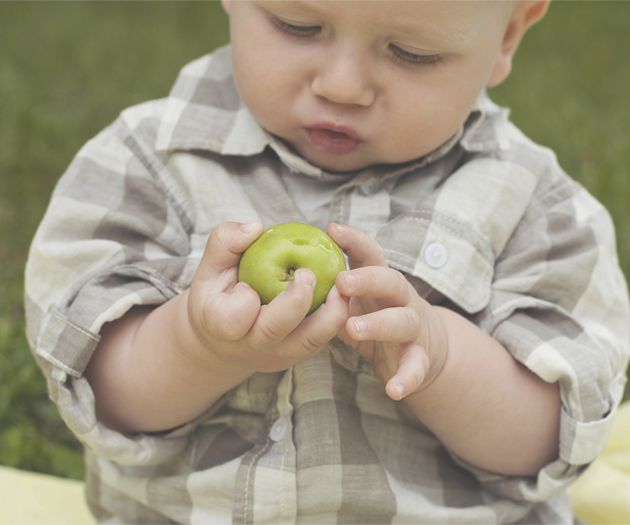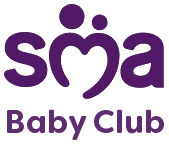At a glance
If you’ve been puréeing foods, try to make them thicker with more texture now
Gradually introduce stage two baby foods that commonly cause allergies. Like eggs, nuts, wheat, shellfish…
Aim for a balanced diet, covering all food groups as part of your weekly meal plans
Get creative by giving your baby new combinations of foods they’re already enjoying
How do I introduce new tastes and textures?
You thought you were doing well getting mini-me to try broccoli, but then you spot a little munchkin at the next table chomping down on cucumber and hummus. Don’t panic, some babies are naturally more tentative with their food exploration while others embrace the new with the enthusiasm of a gourmand in-the-making. The important thing is to offer options and to make food interesting for your baby.
Stage 2 weaning is the moment to try and move towards more solid foods. Don’t worry if mouthfuls are spat out or heads turn away at first – it can take up to eight attempts for baby to accept a new taste. If you’re having problems you can also try weaning finger foods, being tactile can help with the process. Just keep going, taking it one meal at a time.
- Don’t worry too much about table manners and cutlery at this point. Let your baby smell, touch and, yes, play with their food a little. It’s all part of the learning and enjoyment process.
- Eat with your baby. They are little mimics and you’re the centre of their universe. If your baby sees you enjoying healthy food, then it’s likely they’ll want to try it too.
- Try not to have distractions, such as a TV or mobile phone nearby. Meals don’t need to be formal but make eating the focus if you can. You could try a picnic, it’s equally fun indoors or outdoors, for a more messy but relaxed meal.
- If you want to offer baby an alternative drink to milk with their meals, water is ideal.
Go easy on these foods
Everything in moderation is a good rule of thumb and it’s always advisable to plan ahead by creating a stage 2 meal plan. But there are some foods that should be avoided at stage 2 weaning. These are:
- Whole grains (too filling)
- Salty or sugary foods (and there’s no need to add salt or sugar to anything they eat)
- Raw shellfish (risk of food poisoning)
- Shark, swordfish and marlin (contain high levels of mercury)
- Foods high in saturated fat
- Low-fat foods (babies need fat to support growth)
- Whole nuts (choking hazard, offer smooth nut butters instead, but keep an eye out for allergies)
- Honey (risk of containing toxic bacteria)
- Unpasteurised cheese or other dairy products, (risk of listeria)
Keep it balanced
Balance. Trying to achieve it can feel daunting. But you can eat well without being strict or restrictive. As long as you’re mostly getting the basics right, don’t worry if you stray a little now and again.
Here’s a list of the main stage 2 baby food groups your baby should be eating, more or less.
Milk and dairy
Offer your baby different types of pasteurised cheese, yoghurts and fromage frais, making sure you’re giving the full-fat versions and avoiding sugar-laden ‘dessert’ versions.
Between six and twelve months, your baby should be drinking around 500-600 ml of their usual milk a day. For babies over six months old drinking formula milk, you could try SMA® Follow-on Milk which is designed to complement the weaning diet.
Most other milk drinks from cow to oat are not recommended until after one year old as they don’t contain enough essential nutrients. When they approach their first birthday you could talk to your health visitor about which milks are best.
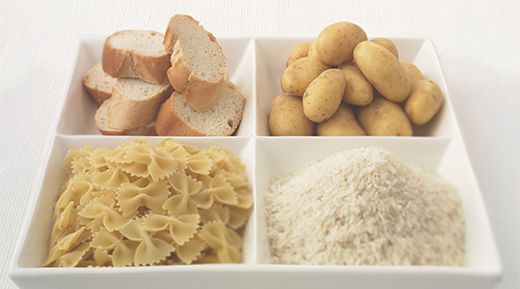
Starchy foods
Rice, pasta, potatoes, fortified breakfast cereals: all really important as they provide calories, B vitamins, folic acid and some calcium and iron.
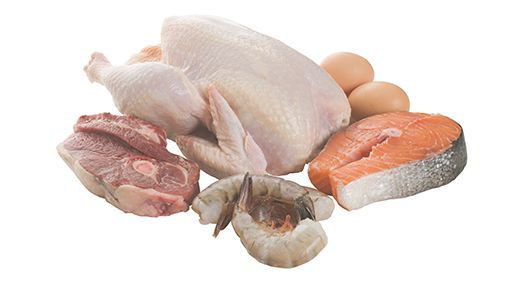
Protein foods
Protein is vital for growth, especially now that your baby is growing at a rate of knots. Luckily there’s a variety of sources including meat, fish, eggs, pulses and nuts, so you’re sure to find a few different ones your baby will enjoy.
When choosing eggs make sure they have the Red Lion stamp. This indicates they’re produced according to the British Lion Code of Practice, and are therefore very low risk for salmonella, and safe for babies and toddlers to eat partially cooked or even raw .
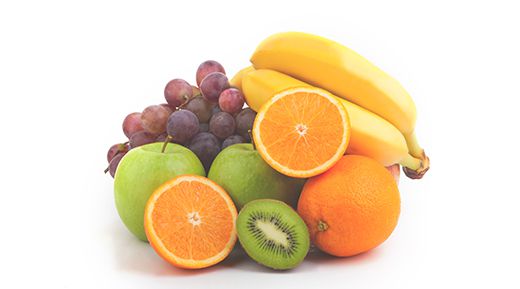
Fruit and vegetables
Whether frozen, fresh or canned, served raw or cooked, fruit and veggies are the backbone of your baby’s weaning journey. They can be served at mealtimes and as snacks, just make sure they have no added sugar or salt.
Watch out for allergic reactions
A food allergy is when the body's immune system mistakenly treats proteins found in food as a threat. Although allergic reactions are often mild, they can be very serious, and even fatal.
Almost any food can cause an allergic reaction, but some culprits are more common than others. It’s important to introduce these foods to your baby one at a time, so you can easily spot any potential reaction. They are:
- Cows' milk
- Wheat and gluten
- Eggs
- Peanuts
- Tree nuts
- Fish and shellfish
- Seeds (like sesame)
- Soya
- Celery
Pre-packaged foods pick out common allergens in their ingredients list (usually in bold, underlined, in italics etc.) so you can identify them more easily.
What does an allergic reaction look like?
Anaphylaxis is the most severe form of allergic reaction and can be fatal if not treated quickly. Call 999 immediately if your child shows these signs:
- Breathing difficulties (including shortness of breath or wheezing).
- Trouble swallowing or struggling to make sounds.
- Pale, floppy, unresponsive or unconscious.
Call your GP if, after introducing a food, your baby has any of the following symptoms:
- Sneezing and an itchy, runny or blocked nose.
- Sore, red and itchy eyes.
- A raised, itchy, red rash (hives).
- Swollen lips, eyes or face (if severe call 999 immediately).
- Tummy pain, vomiting or diarrhoea.
- Dry, red and cracked skin.
If you think your child is showing signs of a severe allergic reaction (anaphylaxis) call 999 right away. You can get even more information on the symptoms of allergies from the NHS
IMPORTANT NOTICE:
We believe that breastfeeding is the ideal nutritional start for babies and we fully support the World Health Organization’s recommendation of exclusive breastfeeding for the first six months of life followed by the introduction of adequate nutritious complementary foods along with continued breastfeeding up to two years of age. We also recognise that breastfeeding is not always an option for parents. We recommend that you speak to your healthcare professional about how to feed your baby and seek advice on when to introduce complementary feeding. If you choose not to breastfeed, please remember that such a decision can be difficult to reverse and has social and financial implications. Introducing partial bottle-feeding will reduce the supply of breast milk. SMA® PRO Follow-on Milk is only suitable for babies over 6 months as part of a mixed diet. It should not be used as a substitute for breast milk during the first 6 months. The decision to start weaning or to use this product before 6 months, should be made only on the advice of a doctor, midwife, health visitor, public health nurse, dietitian or pharmacist, based on baby’s individual needs.





